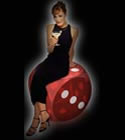Scare Cards Additional Advanced
Watch out for a player who has been calling and standing all bets and raises, and then suddenly starts betting and or raising on the turn or the river when a scare card appears.
You can be sure that either he had the nuts the whole way and was playing tricky or he just made the best hand.
When this happens, especially if the last card could have made the nuts for either high or low, you probably will have to go out no matter how big the pot is and accept your loss.
It is just too unlikely that your opponent would have called all the way in a jammed pot and then change gears and come out betting and / or raising without the last card giving him the cinch.
With poker experience, this situation becomes obvious.
That is, your opponent was drawing for the cinch and was successful in obtaining it.
In a sense, it’s as though his hand was turned over and exposed.
You there have to trim your loss and get out, even though the pot may have become quite large.
Believe me, you virtually will never be wrong in this situation. Here’s an example. You start with




On fourth street, the board is




and the last card is the

If a player who has been just calling all along now bets and the pot is subsequently raised by another player who isn’t likely to be going low, you easily could be against the nut flush as well as the nut low.
By the way, just because a scare cards comes – not a key scare card that makes all the hands, but a card that might make some hands that can beat the hand you have – doesn’t mean that you must check and give up all the bets on the end.
Some players tend to do this every time a card comes that no longer gives them the cinch, even though they had the nuts and still hold close to the nuts.
For example, suppose the last card given in the illustration was the 8 ![]() instead of the 8
instead of the 8 ![]() .
.
In this case, even though someone may have made a straight with a seven-six, automatically throwing away your hand is completely wrong, because the probability of the bets coming from only low hands has increased.
In these spots, you often are better off to go ahead and bet.
If you get raised or the action becomes strong against you, then you can give it up.
At least you discovered with certainly that you are beat without losing too much.
Most of the time, a typical player will be afraid that this scare card helped your hand and frequently will go out.
This is especially true if the situation arises on fourth street. Now your opponent won’t stay around and possibly catch a card that will beat you.
Thus, a scary but not too scary card often can help you, even though it does not improve your hand.
However, remember that if the card is very scary and many poker players are in the pot, you probably are beat and your best course of action is to throw away your hand.
Introduction / Automatic Play / High Versus Low in Three-Handed Pots / Loose Games / Multiway pot Versus Short-Handed Play / Scare Cards / Getting Counterfeited / Getting Quartered / Playing Against Steamers / Playing Against Tight, Solid Players / Your Playing Style / Fluctuations / Pot-Limit Omaha Eight-or-Better / Afterthought


